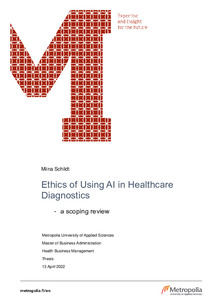Ethics of using AI in healthcare diagnostics : a scoping review
Schildt, Miina (2022)
Schildt, Miina
2022
All rights reserved. This publication is copyrighted. You may download, display and print it for Your own personal use. Commercial use is prohibited.
Julkaisun pysyvä osoite on
https://urn.fi/URN:NBN:fi:amk-202204135113
https://urn.fi/URN:NBN:fi:amk-202204135113
Tiivistelmä
Introduction: Diagnostic AI systems are providing promising results with accurate output, and they offer a great possibility to ease the problems of insufficient human and financial resources. Diagnostic AI systems use sensitive health data, so they carry a high risk of violating fundamental human rights. For that, it is crucial to update the outdated ethical regulations and guidelines for the field of AI. This scoping review aims to define the main ethical aspects of using AI in healthcare diagnostics.
Methods: Literature searches were carried out in databases ProQuest Central, Science Direct and PubMed to find all relevant research published on ethics of diagnostic AI. JBI´s three-step search strategy recommended for scoping reviews was being followed. It included the pilot search, the actual search, and the analysis of the results first on title-level, next on abstract-level, then on full-text level. In addition, more sources were searched in the reference lists of the chosen articles.
Results: Following a systematic search process, 12 articles were included into this review. The inductive content analysis was used to analyse the articles, and the ethical issues recognised from the articles, were organised under the four ethical principles of trustworthy AI defined by the European Commission (2019): respect for human autonomy, prevention of harm, fairness, and explicability.
Conclusion: Ethical diagnostic AI system consists of deep understanding and consideration of ethical issues around it from the point of view of all active stakeholders. In practice this requires ethical discussion to be a fixed and coordinated as a part of the development process of diagnostic AI system, involving system developers, healthcare professionals and experts on AI ethics.
Recommendation for future research: One major finding of this review was that empirical research regarding the topic is non-existent. The author recommends empirical research to be done on how governance of AI ethics is implemented in companies that develop diagnostic AI systems; and then, assessing the effectiveness of these measures from the end-user point of view.
Methods: Literature searches were carried out in databases ProQuest Central, Science Direct and PubMed to find all relevant research published on ethics of diagnostic AI. JBI´s three-step search strategy recommended for scoping reviews was being followed. It included the pilot search, the actual search, and the analysis of the results first on title-level, next on abstract-level, then on full-text level. In addition, more sources were searched in the reference lists of the chosen articles.
Results: Following a systematic search process, 12 articles were included into this review. The inductive content analysis was used to analyse the articles, and the ethical issues recognised from the articles, were organised under the four ethical principles of trustworthy AI defined by the European Commission (2019): respect for human autonomy, prevention of harm, fairness, and explicability.
Conclusion: Ethical diagnostic AI system consists of deep understanding and consideration of ethical issues around it from the point of view of all active stakeholders. In practice this requires ethical discussion to be a fixed and coordinated as a part of the development process of diagnostic AI system, involving system developers, healthcare professionals and experts on AI ethics.
Recommendation for future research: One major finding of this review was that empirical research regarding the topic is non-existent. The author recommends empirical research to be done on how governance of AI ethics is implemented in companies that develop diagnostic AI systems; and then, assessing the effectiveness of these measures from the end-user point of view.
